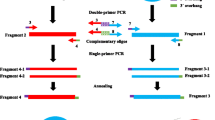Abstract
We demonstrate a method for the isolation of autonomously replicating sequences from pools of clones obtained from genomic DNA libraries constructed using affinity purification of cruciform DNA. The selection of autonomously replicating sequences was based on their differential ability to replicate as episomes after transfection of pools of plasmid clones into human HeLa cells. Two separate libraries containing affinity-purified cruciform DNA were used, one prepared from DNA of log phase primary human genital fibroblasts and the other prepared from DNA of log phase SW48 colon adenocarcinoma cells. Representative samples of the entire phage libraries were converted to phagemid clones by filamentous helper phage-mediated mass excision to produce pBluescript libraries in Escherichia coli. Clones were grown up individually and the bacteria pooled into groups of 48 for recovery of plasmid DNA. Plasmid pools of 48 independent clones (120 μg total) were then transfected by calcium phosphate coprecipitation onto log phase HeLa cells, which were allowed to grow for 3 days before recovery of plasmid by Hirt lysis. The recovery of plasmid from each transfection was estimated to range from 10 to 60 ng. DpnI digestion was then used to digest plasmids which had not been replicated and therefore retained a bacterial methylation pattern which was sensitive to digestion. We estimated from agarose electrophesis gels that 40–200 pg of recovered plasmid DNA per transfected pool of DNA was resistant to DpnI and therefore was capable of transforming competent E. coli cells. The DpnI-resistant fraction yielded from one to seven independent clones from each pool, with genomic DNA inserts ranging in size from 0.35 to 3.4 kb. The fidelity of the procedure was demonstrated by performing duplicate transfections from the same pool of plasmid DNA, and identifying bands which were apparently common between duplicate transfections by size and sequence analysis. A second method of mass screening, using an in vitro DNA replication assay instead of transfections, resulted in similar yields and led to the isolation of an overlapping subset of selected clones.
Similar content being viewed by others
References
Bell D, Sabloff M, Zannis-Hadjopoulos M, Price GB (1991) Anticruciform DNA affinity purification of active mammalian origins of replication. Biochim Biophys Acta 1089:299–308
Desautels L, Brouillette S, Chartrand P (1991) Reciprocal homologous junctions generated in mouse cells. Mol Gen Genet 227:356–360
Frappier L, Price GB, Martin RG, Zannis-Hadjopoulos M (1987) Monoclonal antibodies to cruciform DNA structures. J Mol Biol 193:751–758
Frappier L, Price GB, Martin RG, Zannis-Hadjopoulos M (1989) Characterization of the binding specificity of two anticruciform DNA monoclonal antibodies. J Biol Chem 264:334–341
Graham FL, Van Der Eb AJ (1973) A new technique for the assay of infectivity of human adenovirus 5 DNA. Virology 52:456–467
Hirt B (1967) Selective extraction of polyoma DNA from infected mouse cell cultures. J Mol Biol 26:365–369
Landry S, Zannis-Hadjopoulos M (1991) Classes of autonomously replicating sequences are found among early-replicating monkey DNA. Biochim Biophys Acta 1088:234–244
Maniatis T, Fritsch EF, Sambrook J (1982) Molecular cloning: a laboratory manual. Cold Spring Harbor Laboratory Press, Cold Spring Harbor, New York
Martin RG, Oppenheim A (1977) Initiation points for DNA replication in nontransformed and Simian Virus 40-transformed Chinese hamster lung cells. Cell 11:859–867
Pearson CE, Frappier L, Zannis-Hadjopoulos M (1991) Plasmids bearing mammalian DNA-replication origin-enriched (ors) fragments initiate semiconservative replication in a cell-free system. Biochim Biophys Acta 1090:156–166
Rao BS, Zannis-Hadjopoulos M, Price GB, Reitman M, Martin RG (1990) Sequence similarities among monkey ori-enriched (ors) fragments. Gene 87:233–242
Schmid CW, Manning JE, Davidson N (1975) Inverted repeat sequences in the Drosophila genome. Cell 5:159–172
Southern E (1975) Detection of specific sequences among DNA fragments separated by gel electrophoresis. J Mol Biol 98:503–517
Ward GK, McKenzie R, Zannis-Hadjopoulos M, Price GB (1990) The dynamic distribution and quantification of DNA cruciforms in eukaryotic nuclei. Exp Cell Res 188:235–246
Wilson DA, Thomas CA Jr (1973) Hydroxyapatite chromatography of short double-helical DNA. Biochim Biophys Acta 331:330–340
Wilson DA, Thomas CA Jr (1974) Palindromes in chromosomes. J Mol Biol 84:115–144
Zannis-Hadjopoulos M, Kaufmann G, Martin RG (1984) Mammalian DNA enriched for replication origins is enriched for snap-back sequences. J Mol Biol 179:577–586
Zannis-Hadjopoulos M, Frappier L, Khoury M, Price GB (1988) Effect of anti-cruciform DNA monoclonal antibodies on DNA replication. EMBO J 7:1837–1844
Author information
Authors and Affiliations
Additional information
Communicated by G.P. Georgiev
Rights and permissions
About this article
Cite this article
Nielsen, T., Bell, D., Lamoureux, C. et al. A reproducible method for identification of human genomic DNA autonomously replicating sequences. Molec. Gen. Genet. 242, 280–288 (1994). https://doi.org/10.1007/BF00280417
Received:
Accepted:
Issue Date:
DOI: https://doi.org/10.1007/BF00280417




